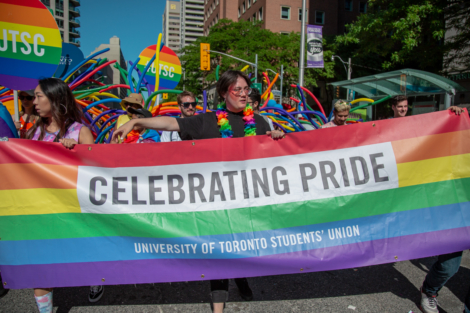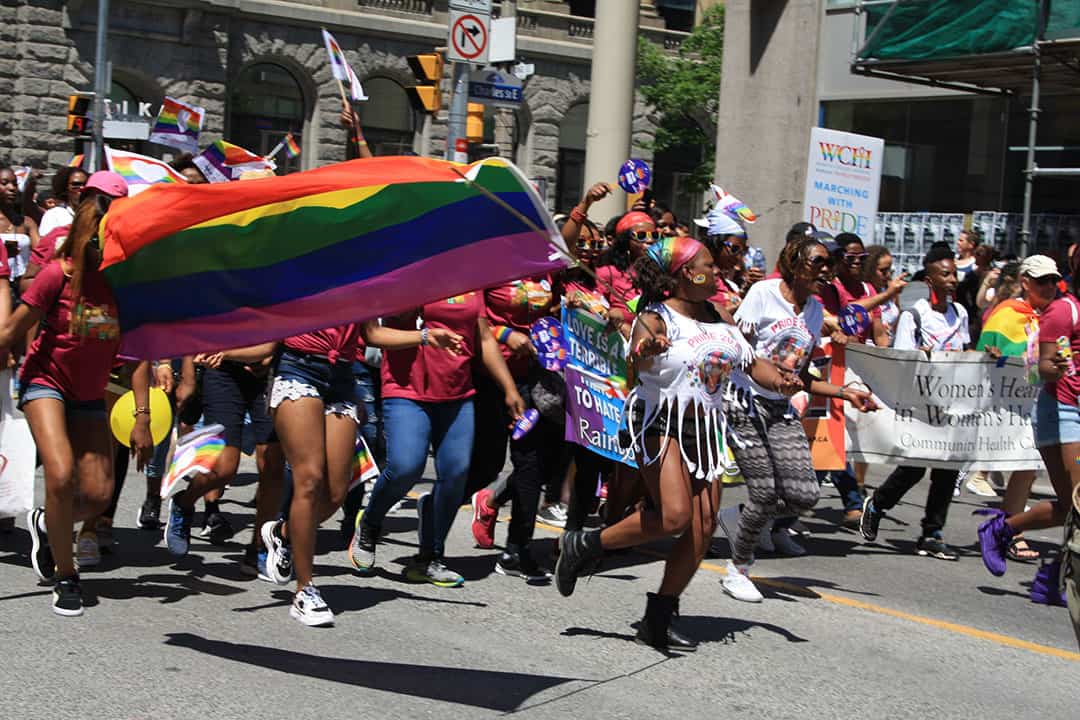On the corner of Bloor and Brunswick you can see a three-storey, nondescript, red-bricked building. A Rexall occupies its lower level, while a walk-in clinic and a family lawyer advertise their services from the top floors.
The building was also the site of one of the most important moments in the history of queer women’s resistance in Toronto.
Before its eventual gentrification, 481 Bloor Street West housed one of Toronto’s most famous watering holes. Nicknamed “the Brunny,” it was a popular Friday night spot among U of T students.
Forty-five years ago, a group of four women, now known as the “Brunswick Four” — Pat Murphy, Adrienne Potts, Sue Wells, and Heather Elizabeth Byer — attended an open mic night at the bar. Potts and Murphy took to the stage and sang “I Enjoy being a Dyke” to the tune of “I Enjoy Being a Girl.” They were ordered to leave, and, after they refused, they were harassed, assaulted, arrested, and charged by police for having supposedly instigated a “lesbian riot.”
Potts was punched in the back of her head, and was later thrown down by one of the officers. Another one of the four was threatened with criminal punishment on false charges, all for having the audacity to sing.
[pullquote]They were ordered to leave, and, after they refused, they were harassed, assaulted, arrested, and charged by police for having supposedly instigated a “lesbian riot.” [/pullquote] That same year, 13 students arrived at a U of T classroom for their first lecture of the semester. Their class, taught by Professor Michael Lynch, was entitled “New Perspectives on the Gay Experience,” and was the first of its kind to be offered in a Canadian university. This garnered negative press, including a snub by the Toronto Star, whose editors refused to publish a story on the class for fear of “[aiding] the aggressive recruitment propaganda in which certain homosexual groups are engaged.”
The attention was distressing for the administrators at St. Michael’s College, which was, and still is, deeply affiliated with its Roman Catholic roots. Following a confrontation with the college principal — one that Lynch dreamed about for years afterward — he was presented with a choice: either keep silent or leave the university entirely. Lynch ended up transferring the following year.
It’s important to be mindful of the fact that in 1974 — the year that both incidents took place — the legality of homosexuality was fresh in Canadian minds. It was only seven years prior that Pierre Trudeau famously quipped that “there’s no place for the state in the bedrooms of the nation.” And it was only in 1973 that the The American Psychiatric Association declared that homosexuality is not a psychiatric disorder.
Neither Canada, Toronto, nor U of T were safe spaces to exist as a queer woman. Making my way along the Dyke March on June 22, past the rumbling engines of the flag-bearing Dykes on Bikes, the political and often hilarious protest signs, and the easy, gentle shows of affection around me, I couldn’t help but marvel at the quiet revolution that has taken place. Mind you, it’s still not easy being a Canadian queer woman: it’s hard, and there are plenty in the community who still struggle. But it’s definitely easier than before, and it came about only through sustained pushback from countless women over the years. The privileges of today were won by the battles of yesterday.
1974 was a pivotal year for queer women organizing in Toronto. Up to that point, efforts had been focused on creating safe spaces for the community, a stark contrast to the politically charged activism of the gay male community. Tom Warner, writing on the response to the Brunswick Four event, notes that it “indicated a radical change in the consciousness of gays, lesbians, and bisexuals, and of a hardening resolve to fight back.”
And fight back they did. The 1980s brought with them a wave of social and political conservatism with the rise of the political “New Right” in Canada. Police officers capitalized on their looser leashes, and started regularly conducting bathhouse raids as an intimidation tactic against the LGBTQ+ community.
The biggest of those raids took place on February 5, 1981. Officers raided four of Toronto’s five bathhouses, taking 306 men into custody on charges of prostitution or indecency, making it the third largest mass arrest in Canadian history. Crowbars and sledgehammers were used to create significant damage to the bathhouses. The community protests which began at Wellesley and Yonge the following night came to be known as the “Canadian Stonewall.” That name was well-earned, considering the police brutality and the fact that over 300 arrests were made that night.
While these raids disproportionately affected gay men, queer women also had a strong presence at the protests and felt, more than ever, the need to create a strong resistance.
Moreover, while transgender people were visible participants in both the protests and in the community, activists and legislative reformers only started to focus on trans-specific issues around the mid-1990s, following increased pressure for change.
Just a few months after the raids, Lesbians Against the Right (LAR) was born at the 519 Community Centre. As its name suggests, LAR was primarily intended to counter the rise of right-wing social conservatism. Unlike previous groups, LAR was a political entity first and a community space second. Its primary goal was to “organize lesbians autonomously from other movements and to bring [their] lesbian feminist politic to the gay, feminist, union, anti-imperialist and other movements for social change.”
On October 17, 1981, LAR, in conjunction with other queer organizations, held Toronto’s first lesbian march. The Dykes In the Streets March saw around 350 women march down Yonge street, chanting slogans like “look over here, look over there, Lesbians are everywhere!” and “we are the D-Y-K-E-S” over and over. A pamphlet published after the march described it as “magical. Nobody wanted to disperse.”
The march passed by important lesbian landmarks around Toronto, but it culminated at Old City Hall. This was a strategic choice. An article written for The Body Politic, Canada’s first, and, at the time, most prominent LGBTQ+ publication, said that the final stop was meant to highlight lesbian resistance to “police harassment, lesbian solidarity with gay men on the bath raids protest, child custody cases of lesbian mothers and the exclusion of lesbians from the Ontario Human Rights Code.”
The LAR closed in 1983, and the Dykes In the Streets March only lasted a year. It was not until 1996 that the first annual Toronto Dyke March took place. However, the 1981 march was an important acknowledgement of the frustration of queer women, and a striking, bold moment of resistance.

UTSU celebrating in the Toronto Pride Parade. DINA DONG/THE VARSITY
The LGBTQ+ community at U of T was not spared from the roiling waters of 1981. Two weeks after the bathhouse raids, Gays at the University of Toronto (GAUT) organized U of T’s first Gay Awareness Week. Events included self-defence classes, a seminar on sexual choice, and a dance party at The Buttery — “Dance your buns off,” suggested the advertisement for the event. Though there is no current Gay Awareness Week at U of T, LGBTQ+ organizations around campus still host many diverse events, aimed more at members of the community rather than those outside of it.
[pullquote]The most disturbing backlash was a “jeans-burning,” in which jeans were lit up and tied to a signpost by students in what The Body Politic described as an “eerie imitation of KKK cross burnings.” [/pullquote]
The event that attracted the most attention was Gay Jeans Day. The GAUT spread pamphlets around campus reading “If you are gay, or support gay rights, wear jeans this Thursday.”
This induced extreme reactions. Engineering students threw shredded computer cards from a balcony onto GAUT members staffing an information booth. Displays were vandalized, and eggs were thrown at windows and tables. The most disturbing backlash was a “jeans-burning,” in which jeans were lit up and tied to a signpost by students in what The Body Politic described as an “eerie imitation of KKK cross burnings.”
In an interview with U of T Magazine, Dan Healey, the head of GAUT and one of the event organizers, did not seem to recall such extremes, saying that, “the occasional egg was thrown at the table, but people generally were polite.” GAUT even received student union funding, as eloquently noted in a Varsity article titled “Gays Get SAC Support.”
Efforts, of course, continued throughout the years. U of T started the Positive Space campaign in 1995, which is now responsible for the small rainbow stickers that adorn many university doors. The Lesbians, Gays, Bisexuals and Trans People of U of T organization was formed, followed by the establishment of Canada’s first LGBTQ Resources & Programs office.
In the broader community, the City of Toronto officially recognized Pride Day in 1991. The first openly lesbian Member of Parliament was elected in 2001, and, four years later, Canada sanctioned same-sex marriage nationwide, becoming the fourth country to do so.
Last Saturday, after meandering past stalls selling overpriced rainbow suspenders, temporary tattoos, and dildos of all shapes and colours, and noting the conspicuous lack of a Progressive Conservative presence against colourful booths from the other three major political parties, I planted my feet in front of the small stage that marked the Dyke March’s starting point.
Following some awkward maneuvering of my camera, recorder, and notebook — “sorry!” I whispered to the couple who kindly smiled at my fumbling — four women took to the stage. A surprising combination of an imam, a lay cantor, an Ojibwe spiritual leader, and a pastor, each spoke of, and for, acceptance of queer women in their respective congregations.
Toward the end of her speech, Imam Teresa Rogers said that “pride has always been a fight for justice.” Scattered applause rang out from the crowd. I think that, looking at queer history in Toronto, this rings true. Queer women activism is not about anger, though it is at times angry. It’s not a privilege, as those who, for some inexplicable reason, want a straight pride may argue. It’s about being able to freely be, without fear or prosecution, and that, in my opinion, is true justice.


